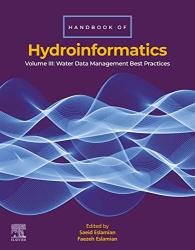Handbook of HydroInformatics: Volume III: Water Data Management Best Practices
- Добавил: literator
- Дата: 23-12-2022, 04:10
- Комментариев: 0
 Название: Handbook of HydroInformatics: Volume III: Water Data Management Best Practices
Название: Handbook of HydroInformatics: Volume III: Water Data Management Best PracticesАвтор: Saeid Eslamian, Faezeh Eslamian
Издательство: Elsevier
Год: 2023
Страниц: 422
Язык: английский
Формат: pdf (true)
Размер: 45.8 MB
Handbook of HydroInformatics Volume III: Water Data Management Best Practices presents the latest and most updated data processing techniques that are fundamental to Water Science and Engineering disciplines. These include a wide range of the new methods that are used in hydro-modeling such as Atmospheric Teleconnection Pattern, CONUS-Scale Hydrologic Modeling, Copula Function, Decision Support System, Downscaling Methods, Dynamic System Modeling, Economic Impacts and Models, Geostatistics and Geospatial Frameworks, Hydrologic Similarity Indices, Hydropower/Renewable Energy Models, Sediment Transport Dynamics Advanced Models, Social Data Mining, and Wavelet Transforms.
This volume is an example of true interdisciplinary work. The audience includes postgraduates and above interested in Water Science, Geotechnical Engineering, Soil Science, Civil Engineering, Chemical Engineering, Computer Engineering, Engineering, Applied Science, Earth and Geoscience, Atmospheric Science, Geography, Environment Science, Natural Resources, Mathematical Science, and Social Sciences. It is a fully comprehensive handbook which provides all the information needed related to the best practices for managing water data.
Optimization techniques can be classified into two types. The first is deterministic optimization techniques, which include linear programming (LP), nonlinear programming (NLP), and dynamic programming (DP). The second type is stochastic optimization including Genetic Algorithm (GA), Particle Swarm Optimization (PSO), Shuffled Complex Evolution, Simulating Annealing (SA), etc. Groundwater management problems are usually nonlinear and nonconvex mathematical programming problems. For such problems, using deterministic optimization techniques can lead to some unforeseen situations. These techniques usually require good initial solutions to produce an optimal solution. Furthermore, they rely on the local gradient of the objective function to determine the search direction, and thus, can converge to local optimal solutions. Therefore, the use of stochastic optimization techniques is generally preferred because of their ability to find solutions without the need for gradients and initial solutions.
Particle swarm optimization (PSO) is a stochastic population-based optimization algorithm inspired by the interactions of individuals in a social world. This algorithm is widely applied in various areas of water resource problems. Particle Swarm Optimization (PSO), which is also an evolutionary computation technique, which is an efficient method for solving large and complex optimization problems. PSO is a member of wide category of swarm intelligence based methods and efficient in global optimization problems.
Soft computing is a revolutionary method for creating computationally intelligent systems that are supposed to possess human knowledge, adapt and learn to do better in evolving environments and clarify how they make decisions. Soft computing aims to combine many various paradigms of computation including ANN, fuzzy logic, and genetic algorithms. When used together, however, the strengths of each strategy can be utilized synergistically by designing low-cost, hybrid systems.
The Machine Learning algorithms is a technique that lets the computational system learn from the knowledge available. Such algorithms work by building a prediction model from a collection of training data that is used later to make predictions guided by evidence. Some of the most common algorithms for machine learning include ANN feed forward and recurrent neural networks, as well as statistical models such as SVR. Traditional standalone machine learning algorithms are not efficient, so metaheuristic algorithms inspired by nature like EA and SI are used in hybrid form. The metaheuristic method applies heuristics inspired by nature in order to combine exploration and exploitation strategies.
Contributions from global experts in the fields of data management research, climate change and resilience, insufficient data problem, etc.
Thorough applied examples and case studies in each chapter, providing the reader with real world scenarios for comparison.
Includes a wide range of new methods that are used in hydro-modeling, with step-by-step guides on how to use them.
Скачать Handbook of HydroInformatics: Volume III: Water Data Management Best Practices
Внимание
Уважаемый посетитель, Вы зашли на сайт как незарегистрированный пользователь.
Мы рекомендуем Вам зарегистрироваться либо войти на сайт под своим именем.
Уважаемый посетитель, Вы зашли на сайт как незарегистрированный пользователь.
Мы рекомендуем Вам зарегистрироваться либо войти на сайт под своим именем.
Информация
Посетители, находящиеся в группе Гости, не могут оставлять комментарии к данной публикации.
Посетители, находящиеся в группе Гости, не могут оставлять комментарии к данной публикации.
